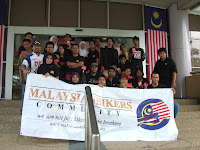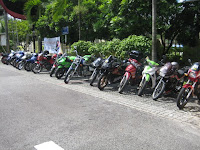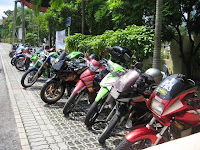Body Position: Old School Vs. New School
In Ama Pro Racing, World Superbike And MotoGP there's been a shift in riding styles. From the days of '80s and '90s heroes like Kevin Schwantz and Mick Doohan who were forced to wrestle powerful, unruly beasts to their will, a younger generation of riders typified by Valentino Rossi and Casey Stoner took over, rising from the high-corner speed ranks of 125cc and 250cc Grand Prix machinery to the more refined, better-behaved MotoGP bikes of today with their complex engine-management software and traction control. Actually Rossi's career dates from the final days of fire-breathing 500cc two-strokes (he won the last 500CC World Championship in 2001, then piled up consecutive MotoGP championships from 2002 to 2005), which likely contributes to making him the most versatile and perhaps most talented roadracer of all time.
Focusing on riding styles, in particular body position while hanging off during cornering, we see the evolution from the more upright chest-over-the-tank style of the past couple of decades to the radically to-the-inside and almost under-the-bike shenanigans of the youngsters. The old school still has some fight left, as exemplified by former World Superbike champions Troy Bayliss (a dominant force in the series and currently leading WSBK points) and Neil Hodgson, one of our interview subjects here, who makes his return to AMA Superbike competition to take care of some unfinished business. Representing the new-schoolers is multitime AMA champion and factory Yamaha superbike pilot Eric Bostrom, a man who first popularized the modern style in the AMA competition despite his dirt-track and four-stroke background. When asked if the difference in riding styles comes from the younger generation's experience being limited to modern chassis and tire technology, Hodgson scratches his head and says, "Yeah, it's very possible; I've never analyzed it that way, but now that you've said it you're probably right."

Old school: Former World Superbike Champion (2003) and British Superbike Champion (2000), Neil Hodgson, 34, began riding at the age of three and racing at nine. His style mimics that of his two all-time favorite riders, Kevin Schwantz and Mick Doohan. Like most champions, Hodgson (5 feet 9 inches and 155 pounds) is highly critical of his riding and admits that if he had it to do over again, "I'd try to get my weight off the bike a little more." Still, Hodgson was chosen from among many talented riders by American Honda to team up with Miguel Duhamel and race the all-new Honda CBR1000RR. He proved blindingly quick on his one-off ride on a Honda CBR600RR Formula Xtreme bike at Daytona.
Hodgson
Hodgson has been racing for 25 years, which along with being a proven world champion, likely contributed to his landing the much-sought-after seat on the factory American Honda Superbike team for 2008. Like any true champion Hodgson is also his own toughest critic. "I think your style is your style and it's hard to change it. I've criticized my own style and want to hang off more, but if I hang off more I lose the feeling for the bike," he admits. "It's so ingrained into me because I've been racing for so many years that I can't change it now. I can, but I go slower."
Hodgson's style comes from the days of Schwantz and Doohan, when high-horsepower engines dominated underdeveloped chassis and tire technology; wheels were rarely in line with one another when the beasts were ridden in anger. Despite his somewhat retro riding style, however, Hodgson surprised many, including perhaps himself, when he snatched the pole qualifying position for this year's Daytona 200 in a one-off ride on a Honda CBR600RR Formula Xtreme racebike. All the more impressive is that it was the first time in his career he's ever raced a 600.
Clearly, getting the most out of a 600 requires an emphasis on corner speed, so despite his relatively upright upper-body position Hodgson works his lower body to at least partially compensate. To keep the rear wheel on the ground under maximum braking, "I'm up against the tank in the corners, but then when I brake I always pull myself away from the tank, just obviously trying to keep the weight as far back as possible," he explains. "I move around on the seat a lot, really. A lot of riders, like Ben Spies, don't move around on the seat a lot; he moves his upper body around over it. I move my bum on the seat, but my upper body stays in the same position, so I try to keep a lower center of gravity by getting more of my backside off but keeping my upper body over the center."
There's no disputing the effectiveness of Hodgson's riding; however, you need only look to MotoGP to see that the most advanced tire, chassis and engine-management technology in our sport has the days of old-school riding styles numbered.

New school: Four-time AMA National Champion, Eric Bostrom, 5 feet 10 inches and 29 years old, is a veteran of the new-school ranks. His success began in dirt-track, and along with older brother and former AMA Superbike Champion Ben Bostrom, he successfully transitioned to roadracing. Eric's forward, head-low position keeps his upper body well off to the inside of the bike in an effort to keep it as upright as possible and maximize traction. When they're comfortable with their bike setup the Bostroms are all but unbeatable.
Bostrom
When Eric Bostrom splashed onto the AMA Pro Racing scene, first dominating the Harley-Davidson Twin Sports class in 1997 and then Formula Xtreme in 1998 on an Erion Honda (winning all but one event in each season), his radically hung-off style was a bit of a curiosity, as if he were more of a lanky 125cc GP refugee than the dirt-track kid he actually was. When filling in for an injured Miguel Duhamel on a few factory Honda RC45 guest appearances, however, he won two of his first three superbike races. After that everyone took him seriously as a force to be reckoned with.
As puzzling as the development of his style was to the rest of us, it made perfect sense to Bostrom. "Obviously I came from dirt-track," he explains, "and in dirt-track you always wanted to keep your bike on top of the tire, and you use a lot of body English in dirt-track to try to find the grip. If I have that one thing that's my forte, it's finding grip. So that's how I developed, always thinking like a dirt-tracker."
Bostrom keeps his head so low, nearly always behind or physically beneath the bike's windscreen, that Schwantz once described it as if he had a six-inch string connecting his helmet chin bar to the top triple clamp. Former Bostrom crew chief, the late Merlyn Plumlee, noted the challenge of needing to trim back the trailing edge of the windscreen and upper fairing to keep them from interfering with Bostrom's helmet.
No one with even a fundamental understanding of physics doubts the advantages of keeping the rider's weight as low and to the inside as possible, but Bostrom also sees a compromise to his style when it comes to tires overcoming available traction. "I've gotta believe that their riding style is better for saving crashes, you know," he admits, "because you have more leverage to pick the bike up when you lose the front end." The Achilles heel in Bostrom's riding does seem to be his lack of ability to adapt to and overcome setup challenges.
With regard to where he positions himself on the seat, Bostrom details, "I'm mostly pretty forward on the seat [while cornering] but definitely back on the brakes. I change my position constantly. It depends on the corner-if you're into a corner that's not that heavy on braking then you can enter it straight from the front, but sometimes your front tires are so good that, like turn five here [at Miller Motorsports Park in 2006], I'll be on the back of the seat at the apex, still trying to get the bike stopped and still trailing because the front tires will take it. So you're not really in the right position (for steering the bike), but you need that weight back there because the rear is trying to come around."
The Way Of The Future
In terms of pure physics, the advantages of the new-school style of riding cannot be denied. The lower and farther off to the inside the rider gets his body, the more upright the bike is around a given radius at a given speed. Pure and simple, more is better, so long as your body position doesn't compromise your ability to stay connected to the bike so you can feel what's happening at both contact patches and maintain light and precise inputs on the controls. Since the days of rigid frames and spoked wheels, riding styles are constantly changing. Bike and tire technology, like time, marches forward and waits for no man-not even Schwantz or Doohan.
Source --> http://www.sportrider.com/

















































































































